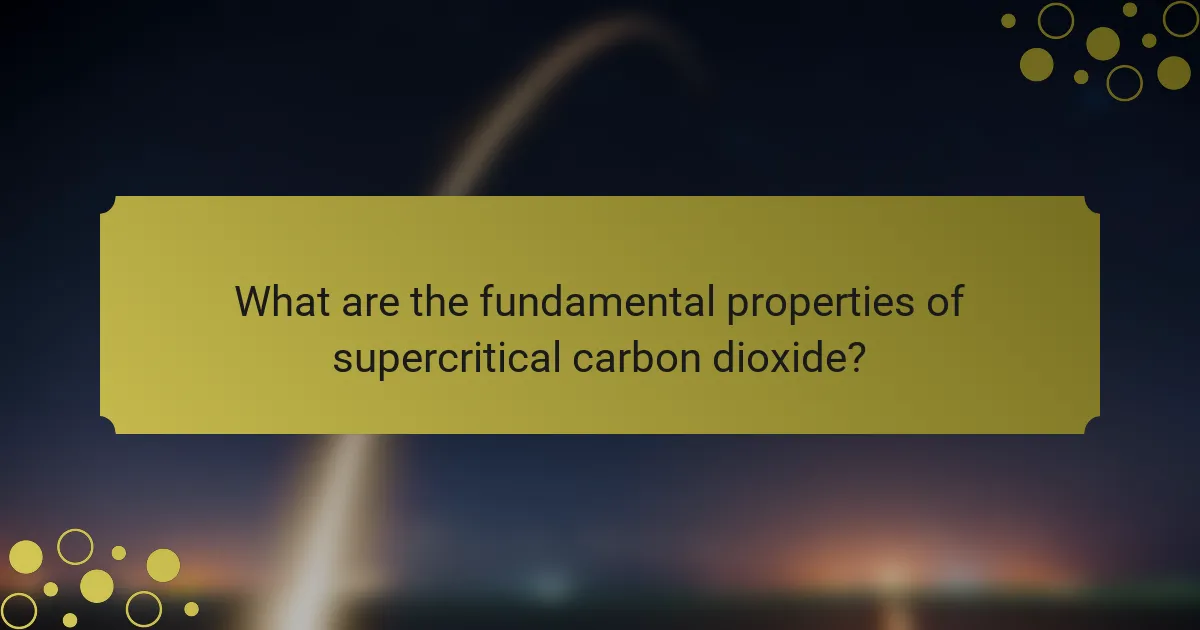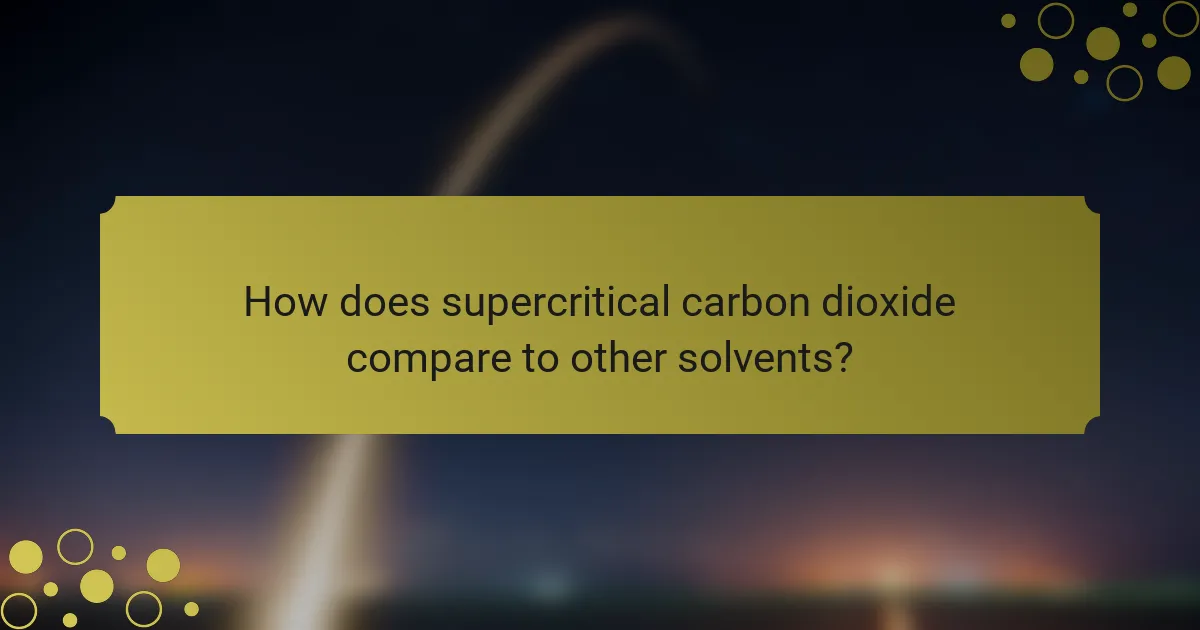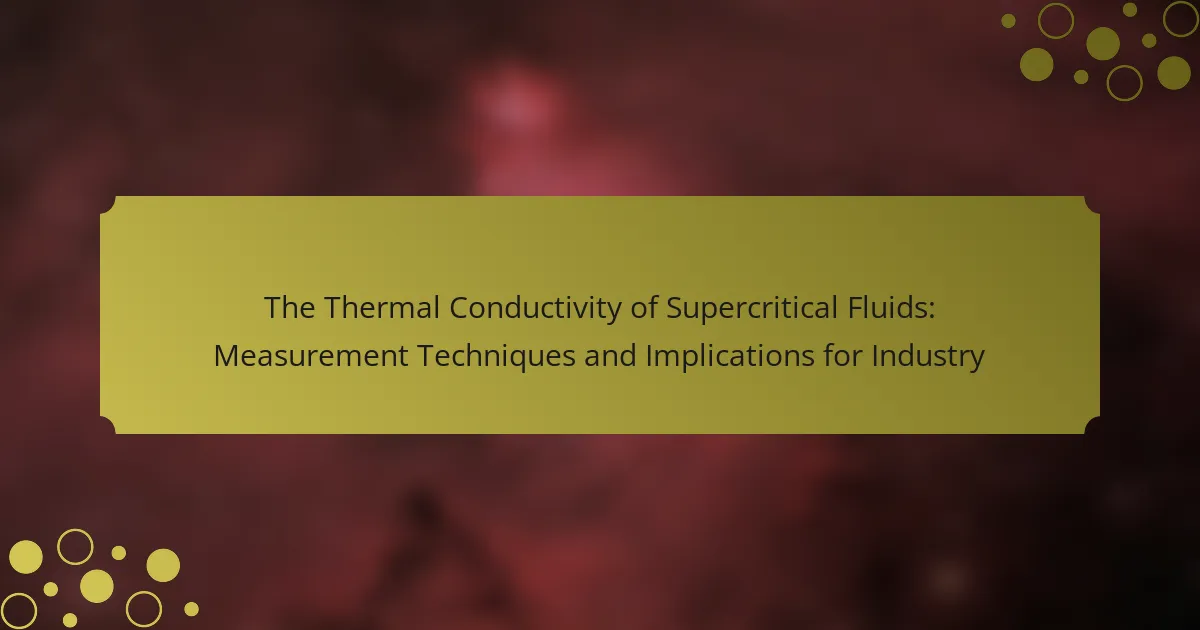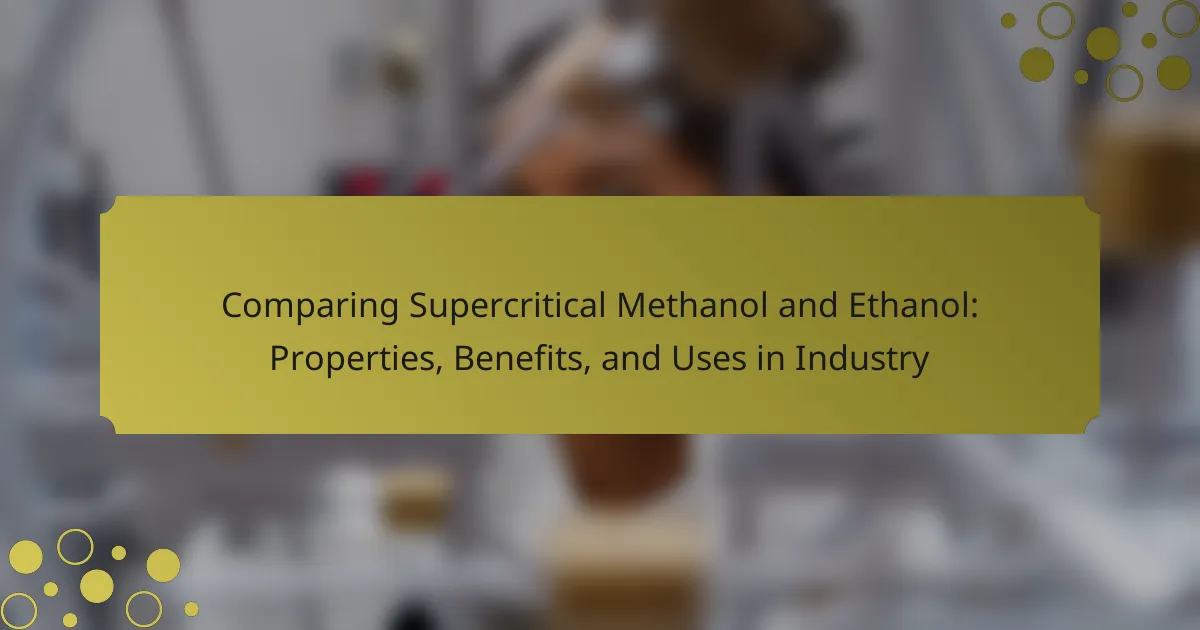Supercritical carbon dioxide (scCO2) is a state of carbon dioxide characterized by its unique properties, occurring above a critical temperature of 31.1°C and a critical pressure of 73.8 bar. In this state, scCO2 exhibits a density akin to liquids while maintaining gas-like viscosity, making it an effective solvent for various non-polar compounds. The article explores the solubility characteristics, temperature range, and operational advantages of scCO2, particularly in extraction processes for essential oils and pharmaceuticals. Additionally, it highlights its applications in the food industry, such as coffee decaffeination, and its role in polymer processing, emphasizing its non-toxic and environmentally friendly nature. Overall, scCO2’s versatility positions it as a significant alternative to traditional solvents across multiple industries.

What are the fundamental properties of supercritical carbon dioxide?
Supercritical carbon dioxide (scCO2) is a state of carbon dioxide that exhibits unique properties. It occurs above its critical temperature of 31.1°C and critical pressure of 73.8 bar. In this state, scCO2 has a density similar to that of a liquid but behaves like a gas in terms of viscosity. Its solubility characteristics are significant; scCO2 can dissolve a variety of non-polar compounds, making it useful in extraction processes. The temperature range for scCO2 operation typically spans from 31.1°C to around 60°C for many applications. Its low surface tension allows for effective [censured] into materials. Additionally, scCO2 is non-toxic and environmentally friendly, enhancing its appeal in various industries.
How is the density of supercritical carbon dioxide defined?
The density of supercritical carbon dioxide is defined as the mass per unit volume of carbon dioxide in its supercritical state. Supercritical carbon dioxide exists above its critical temperature of 31.1°C and critical pressure of 73.8 atm. In this state, it exhibits properties of both gases and liquids. The density can vary significantly with temperature and pressure changes. Typically, the density of supercritical carbon dioxide ranges from 0.2 to 0.9 g/cm³. This variation is crucial for applications in extraction and material processing. The density is influenced by the specific conditions under which it is used.
What factors influence the density of supercritical carbon dioxide?
The density of supercritical carbon dioxide is influenced by temperature and pressure. As temperature increases, the density decreases due to expanded molecular motion. Conversely, increasing pressure compresses the gas, raising its density. The critical temperature of carbon dioxide is 31.1°C, above which it cannot be liquefied by pressure alone. At the critical pressure of 73.8 atm, carbon dioxide transitions to a supercritical state. Density variations can also occur due to impurities in the carbon dioxide. These impurities can alter the interactions between molecules, affecting overall density. Thus, temperature, pressure, and purity are critical factors influencing the density of supercritical carbon dioxide.
How does density vary with temperature and pressure in supercritical carbon dioxide?
Density of supercritical carbon dioxide decreases with increasing temperature and increases with increasing pressure. As temperature rises, the kinetic energy of the molecules increases, leading to greater molecular spacing. This results in a lower density at higher temperatures. Conversely, increasing pressure compresses the molecules closer together, raising the density. For example, at 31°C and 73.8 atm, the density of supercritical carbon dioxide is approximately 0.47 g/cm³. At higher temperatures, such as 40°C, the density drops to around 0.36 g/cm³ at similar pressures. Thus, both temperature and pressure significantly influence the density of supercritical carbon dioxide.
What role does solubility play in supercritical carbon dioxide applications?
Solubility is crucial in supercritical carbon dioxide applications as it determines the ability of substances to dissolve in this state. High solubility enhances the extraction efficiency of compounds from various materials. This property allows supercritical carbon dioxide to act as an effective solvent in processes like extraction and chromatography. For instance, supercritical carbon dioxide can dissolve essential oils, flavors, and pharmaceutical compounds efficiently. The solubility of solutes in supercritical carbon dioxide is influenced by temperature and pressure. Increasing pressure typically increases solubility, while temperature changes can either enhance or reduce it. Studies show that supercritical carbon dioxide can dissolve non-polar and moderately polar compounds effectively. This makes it a preferred choice in green chemistry applications, reducing the need for harmful organic solvents.
How does the solubility of different substances change in supercritical carbon dioxide?
The solubility of different substances in supercritical carbon dioxide varies significantly. Solubility is influenced by the substance’s polarity and molecular weight. Non-polar substances generally have higher solubility in supercritical carbon dioxide. This is due to the similar non-polar nature of carbon dioxide in its supercritical state. Conversely, polar substances exhibit lower solubility. The density of supercritical carbon dioxide also affects solubility. As density increases, solubility for certain compounds can increase as well. Temperature and pressure adjustments can further optimize solubility levels. Research indicates that the solubility of organic compounds can be enhanced by altering these parameters.
What are the implications of solubility for extraction processes using supercritical carbon dioxide?
Solubility significantly affects extraction processes using supercritical carbon dioxide (SC-CO2). Higher solubility of target compounds in SC-CO2 enhances extraction efficiency. This leads to greater yields and reduced extraction times. Solubility is influenced by temperature and pressure adjustments in the SC-CO2 system. Increased pressure generally improves solubility, allowing more compounds to dissolve. Conversely, temperature changes can either increase or decrease solubility, depending on the specific compound. Understanding solubility dynamics helps optimize extraction parameters for specific applications. Research indicates that solubility variations can impact the selectivity of extracted compounds. Thus, tailoring conditions based on solubility is crucial for effective SC-CO2 extraction.
What is the temperature range for supercritical carbon dioxide?
The temperature range for supercritical carbon dioxide is typically between 31.1°C and 31.3°C. At this range, carbon dioxide transitions into a supercritical state. Above 31.3°C, carbon dioxide remains supercritical as pressure increases. This state enables unique properties, such as increased solubility of certain compounds. Supercritical carbon dioxide is widely used in extraction processes and as a solvent.
How do temperature changes affect the properties of supercritical carbon dioxide?
Temperature changes significantly affect the properties of supercritical carbon dioxide (SC-CO2). As temperature increases, the density of SC-CO2 decreases. This occurs because higher temperatures provide more kinetic energy to the molecules, causing them to occupy a larger volume. Conversely, lowering the temperature increases the density as the molecules come closer together.
Additionally, temperature influences the solubility of substances in SC-CO2. Higher temperatures generally enhance solubility for many compounds. This is particularly relevant in extraction processes, where increased solubility at elevated temperatures can improve yield.
The critical temperature of carbon dioxide is approximately 31.1°C. Above this temperature, carbon dioxide cannot exist as a liquid regardless of pressure. Therefore, understanding how temperature impacts SC-CO2 is crucial for applications in extraction, reaction processes, and material synthesis.
What are the critical temperature and pressure values for carbon dioxide?
The critical temperature for carbon dioxide is 31.1 degrees Celsius. The critical pressure for carbon dioxide is 7.38 MPa (megapascals). At these values, carbon dioxide transitions into a supercritical fluid. This state exhibits unique properties, such as enhanced solubility and density. These characteristics make supercritical carbon dioxide useful in various applications, including extraction processes.

How does supercritical carbon dioxide compare to other solvents?
Supercritical carbon dioxide (scCO2) is a versatile solvent that offers several advantages over traditional solvents. It has a low viscosity and high diffusivity, enabling efficient extraction processes. scCO2 operates at relatively low temperatures, preserving heat-sensitive compounds. Unlike many organic solvents, it is non-toxic and environmentally friendly. Its tunable properties allow for adjustments in density and solubility by varying pressure and temperature. In comparison, common solvents like ethanol and hexane may pose health risks and environmental concerns. Studies show that scCO2 can effectively extract essential oils and pharmaceuticals, often outperforming conventional solvents in yield and purity.
What advantages does supercritical carbon dioxide have over traditional solvents?
Supercritical carbon dioxide (scCO2) offers several advantages over traditional solvents. It is non-toxic and environmentally friendly, reducing health risks and environmental impact. scCO2 has tunable solubility, allowing for better extraction of specific compounds. Its low viscosity enhances mass transfer efficiency during processes. Additionally, scCO2 can be easily removed from products, leaving no solvent residues. Traditional solvents often require extensive purification steps, which scCO2 eliminates. Furthermore, scCO2 operates at lower temperatures, preserving heat-sensitive compounds. These advantages make scCO2 a preferred choice in various extraction and processing applications.
Why is supercritical carbon dioxide considered a green solvent?
Supercritical carbon dioxide is considered a green solvent because it is non-toxic and environmentally benign. It does not contribute to air or water pollution. Supercritical CO2 can replace organic solvents in various applications, reducing hazardous waste. Its low viscosity and high diffusivity enhance extraction efficiency. Additionally, supercritical CO2 can be easily recycled and reused in processes. Studies show that it can effectively extract compounds without harmful residues. This makes it a sustainable alternative in chemical processes and extractions.
How does the efficiency of supercritical carbon dioxide compare to other extraction methods?
Supercritical carbon dioxide (SC-CO2) is more efficient than many traditional extraction methods. Its efficiency stems from its ability to selectively extract compounds at lower temperatures. This reduces thermal degradation of sensitive materials. SC-CO2 can also be easily tuned by adjusting pressure and temperature. This adaptability allows for optimized extraction of specific compounds. In contrast, methods like solvent extraction often require higher temperatures and longer processing times. Studies show that SC-CO2 can extract essential oils with higher yields compared to ethanol or hexane. The extraction rate of SC-CO2 can be up to three times faster than traditional methods. Overall, SC-CO2 demonstrates superior efficiency in extracting valuable compounds.
What are the limitations of using supercritical carbon dioxide?
Supercritical carbon dioxide (scCO2) has several limitations. One limitation is its relatively low solvent power for polar compounds. This restricts its use in extracting certain substances effectively. Another limitation is the requirement for high pressure and temperature to achieve the supercritical state. This can lead to increased operational costs and complexity. Additionally, scCO2 may not be suitable for all materials due to its non-polar nature. Some compounds may degrade or react unfavorably in its presence. Furthermore, the equipment needed to handle scCO2 safely can be expensive and require specialized knowledge. These factors can limit its practical applications in various industries.
In what scenarios is supercritical carbon dioxide not the ideal choice?
Supercritical carbon dioxide is not the ideal choice in scenarios requiring high polarity solvents. Its non-polar nature limits its effectiveness in extracting polar compounds. Additionally, supercritical carbon dioxide is unsuitable for processes requiring low temperatures. The high operational temperatures can degrade sensitive materials. In situations demanding high viscosity solvents, supercritical carbon dioxide may not provide adequate flow characteristics. Furthermore, it is ineffective in applications needing a wide range of solubility for diverse compounds. Lastly, in cases involving large-scale industrial processes, the initial setup and operational costs may be prohibitive.
How can challenges associated with supercritical carbon dioxide be mitigated?
Challenges associated with supercritical carbon dioxide can be mitigated through careful process design and optimization. Implementing precise temperature and pressure controls enhances stability. Utilizing additives can improve solubility and extraction efficiency. Regular maintenance of equipment prevents operational failures. Research indicates that optimizing flow rates can reduce mass transfer limitations. Furthermore, employing advanced monitoring technologies aids in real-time adjustments. These strategies collectively enhance the efficacy of supercritical carbon dioxide applications.

What practical applications utilize the properties of supercritical carbon dioxide?
Supercritical carbon dioxide (scCO2) is utilized in various practical applications due to its unique properties. It serves as a solvent in extraction processes, particularly for essential oils and natural compounds. The high solubility of certain substances in scCO2 makes it effective for extracting flavors and fragrances.
In the food industry, scCO2 is used to decaffeinate coffee, preserving flavor while removing caffeine. Additionally, scCO2 is employed in the production of pharmaceuticals, where it aids in the extraction of active ingredients. Its non-toxic nature and ability to replace organic solvents enhance safety and sustainability in manufacturing processes.
Furthermore, scCO2 is applied in polymer processing, where it assists in foaming and shaping materials. This method reduces environmental impact by minimizing the use of harmful chemicals. Overall, the versatility of supercritical carbon dioxide in these applications highlights its significance in various industries.
How is supercritical carbon dioxide used in food processing?
Supercritical carbon dioxide is used in food processing primarily for extraction and preservation. It acts as a solvent to extract flavors, colors, and nutrients from food products. Supercritical CO2 can dissolve non-polar compounds, making it effective for extracting essential oils and natural flavors. This process is often preferred over traditional solvents due to its non-toxic nature. Furthermore, supercritical CO2 can inhibit microbial growth, extending the shelf life of food products. Studies show that this method retains the quality and nutritional value of the food better than conventional methods. The ability to operate at low temperatures also helps in preserving heat-sensitive compounds.
What benefits does supercritical carbon dioxide offer in food extraction?
Supercritical carbon dioxide (SC-CO2) offers several benefits in food extraction. It is a non-toxic and environmentally friendly solvent. SC-CO2 effectively extracts essential oils, flavors, and nutrients from food materials. It operates at lower temperatures, preserving heat-sensitive compounds. The density of SC-CO2 can be adjusted, enhancing its solubility for various compounds. This flexibility allows for selective extraction, targeting specific components. Additionally, SC-CO2 leaves no harmful residues, making it safe for food products. Studies show that SC-CO2 extraction can yield higher quality extracts compared to traditional methods.
How does supercritical carbon dioxide impact food quality and safety?
Supercritical carbon dioxide (SC-CO2) enhances food quality and safety by acting as a natural preservative. It effectively eliminates pathogens and spoilage organisms without leaving harmful residues. SC-CO2 penetrates food matrices, improving extraction of flavors and nutrients. This process maintains the sensory attributes of food products. Research shows that SC-CO2 treatment reduces microbial load significantly. For instance, a study published in the Journal of Food Science demonstrated a 99.9% reduction in Salmonella and E. coli in treated foods. Additionally, SC-CO2 maintains the nutritional profile of food by minimizing thermal degradation. Overall, SC-CO2 serves as a safe and effective method for improving food quality and safety.
What role does supercritical carbon dioxide play in pharmaceuticals?
Supercritical carbon dioxide (scCO2) serves as a solvent in pharmaceutical applications. It effectively extracts active pharmaceutical ingredients (APIs) due to its tunable density and solubility properties. ScCO2 can dissolve both polar and nonpolar compounds, enhancing extraction efficiency. This method reduces the need for organic solvents, making it environmentally friendly. Additionally, scCO2 is utilized in the formulation of drug delivery systems. Its low toxicity and ability to penetrate materials allow for the creation of micro and nanoparticles for targeted delivery. Studies have shown that scCO2 extraction can yield high-purity compounds with minimal thermal degradation.
How does supercritical carbon dioxide enhance drug formulation processes?
Supercritical carbon dioxide enhances drug formulation processes by acting as a solvent with unique properties. It has tunable density, which allows for improved solubility of various compounds. This solubility can be adjusted by changing temperature and pressure, optimizing the extraction and formulation of drugs. Supercritical carbon dioxide is non-toxic and environmentally friendly, making it a safer alternative to organic solvents. Additionally, it can facilitate the production of nanoparticles, which can improve drug delivery. Studies show that using supercritical carbon dioxide can increase the bioavailability of certain drugs. This method also reduces the need for harmful solvents, aligning with green chemistry principles.
What are the challenges faced in pharmaceutical applications of supercritical carbon dioxide?
Pharmaceutical applications of supercritical carbon dioxide face several challenges. One significant challenge is the limited solubility of certain compounds in supercritical CO2. This restricts the range of pharmaceuticals that can be effectively processed. Another challenge is the high pressure and temperature required for supercritical conditions. These conditions can complicate equipment design and increase operational costs. Additionally, the process can lead to the degradation of sensitive pharmaceutical compounds. This degradation can impact the efficacy and safety of the final product. Lastly, regulatory hurdles can arise due to the novel nature of supercritical CO2 technology. These hurdles can slow down the adoption of this method in the pharmaceutical industry.
What best practices should be followed when working with supercritical carbon dioxide?
When working with supercritical carbon dioxide, ensure proper safety protocols are in place. Use appropriate personal protective equipment, including gloves, goggles, and lab coats. Maintain equipment integrity by regularly inspecting pressure vessels and connections. Ensure proper ventilation in work areas to prevent gas accumulation. Monitor temperature and pressure consistently to avoid hazardous conditions. Follow manufacturer guidelines for equipment operation and maintenance. Implement emergency procedures for leaks or system failures. Training personnel on handling supercritical fluids is essential for safety and efficiency.
Supercritical carbon dioxide (scCO2) is a unique state of carbon dioxide characterized by specific properties such as density, solubility, and temperature range. This article examines the fundamental properties of scCO2, including its critical temperature of 31.1°C and pressure of 73.8 bar, and how these factors influence its density and solubility for various applications. Key discussions include the impact of temperature and pressure on density, the role of solubility in extraction processes, and the advantages of scCO2 over traditional solvents in industries like food and pharmaceuticals. Additionally, the article addresses the limitations and best practices for working with scCO2 in practical applications.



